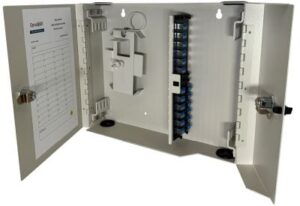Top 5 Reasons to Upgrade to High-Density LC Fiber Patch Panels for Your Data Center

In today’s fast-paced digital landscape, data centers play a pivotal role in supporting the various operations of modern businesses. They are responsible for housing essential components such as storage systems, servers, and networking equipment, which keep our digital ecosystem functioning seamlessly. As the backbone of the digital age, these infrastructures ensure smooth data flow, enabling businesses to operate efficiently. One of the crucial, yet often overlooked elements at the core of this infrastructure is the LC fiber patch panel. Though it may seem like a minor component, its role in ensuring seamless data transmission is indispensable. LC fiber patch panels help organize and manage fiber optic cables, directly impacting network performance and efficiency.

Why Fiber Patch Panels Matter
A fiber patch panel acts as the central hub for managing and organizing fiber optic cables within a network. By providing a structured way to connect multiple network devices, these panels simplify cable management and streamline data transmission, allowing for faster, more efficient communication across the network. Without these panels, data centers would face increased complexity and disorganization, potentially leading to increased downtime and errors due to unmanageable cabling.
Fiber patch panels are essential not only for organizing cables but also for minimizing signal loss, reducing downtime, and improving the overall performance of the network. As businesses increasingly rely on high-speed, high-bandwidth networks, the need for reliable, scalable connectivity solutions becomes even more critical. Fiber patch panels play a key role in ensuring that data flows smoothly and securely across today’s interconnected world, acting as the unsung heroes of modern networking.
The Benefits of High-Density LC Fiber Patch Panels
When it comes to managing large-scale data center infrastructure, upgrading to high-density LC fiber patch panels provides significant advantages. These panels are designed to accommodate more ports in less physical space, making them an ideal choice for growing networks that demand increased bandwidth and efficiency. Below, we’ll explore five key reasons why investing in high-density LC fiber patch panels can transform your data center’s performance.
1. Space Optimization
One of the most significant advantages of upgrading to high-density LC fiber patch panels is their ability to optimize space. Traditional patch panels, with their limited port densities, often require multiple panels to handle growing network connections. This can take up valuable rack space and contribute to cable clutter, making management difficult. High-density LC fiber patch panels, on the other hand, can accommodate a large number of ports within the same physical footprint. This not only reduces the amount of space required but also simplifies cable management, leading to a more organized and efficient data center. Furthermore, by consolidating network connections into fewer panels, airflow is improved, helping to reduce heat and increase overall system performance.
2. Enhanced Network Performance
High-density LC fiber patch panels are designed to enhance network performance, particularly when paired with LC connectors, known for their compact size and superior connection reliability. LC connectors offer higher density compared to older SC connectors, enabling faster data transfer rates, reduced latency, and improved responsiveness of applications. This makes them especially valuable in data centers where high-bandwidth, low-latency connections are critical to business operations. By upgrading to high-density LC panels, businesses can ensure that their data center infrastructure is equipped to handle the demands of modern applications, leading to smoother, more efficient services and operations.
3. Future-Proofing Your Network
As businesses continue to grow and evolve, so do their data center requirements. Investing in high-density LC fiber patch panels offers a scalable solution that can easily accommodate future expansion. These panels are designed to support a large number of ports, allowing them to handle increased network traffic and connect additional devices as your data center grows. By upgrading now, businesses can avoid the need for frequent infrastructure upgrades in the future, saving time, money, and resources. Essentially, high-density LC fiber patch panels allow data centers to grow alongside the business, ensuring that the network infrastructure can support future needs without major disruptions.
4. Improved Cable Management
Effective cable management is critical to maintaining an organized and efficient data center. High-density LC fiber patch panels play a significant role in simplifying cable management, thanks to their compact design, which allows for a more organized and neater cable layout. This not only reduces clutter but also improves airflow within the server room, contributing to system reliability. Poor cable management can lead to equipment failures due to overheating or physical damage to cables. By using high-density fiber patch panels, businesses can avoid these risks, improving the longevity of their equipment and minimizing the chances of costly downtime.

5. Cost Efficiency
While the initial cost of upgrading to high-density LC fiber patch panels may seem significant, the long-term savings can be substantial. By optimizing space and improving network performance, these panels help reduce operational costs. Fewer panels mean less rack space, lower cooling costs, and simpler maintenance. Additionally, their scalability helps prevent costly infrastructure overhauls as the business grows. Investing in high-density LC fiber patch panels can lead to improved efficiency, reduced downtime, and overall cost savings, making it a smart financial decision in the long run.
Conclusion
Upgrading to high-density LC fiber patch panels is a strategic move for any data center looking to improve performance, efficiency, and scalability. These panels offer numerous benefits, including space optimization, enhanced network performance, future-proof scalability, improved cable management, and long-term cost efficiency. As businesses increasingly rely on high-speed, high-bandwidth networks, the demand for reliable, scalable connectivity solutions will only continue to grow. By investing in high-density LC fiber patch panels now, businesses can ensure that their data centers are well-equipped to handle both current demands and future growth. If you are considering a network upgrade, high-density LC fiber patch panels should be at the top of your list for improving data center efficiency and performance.








